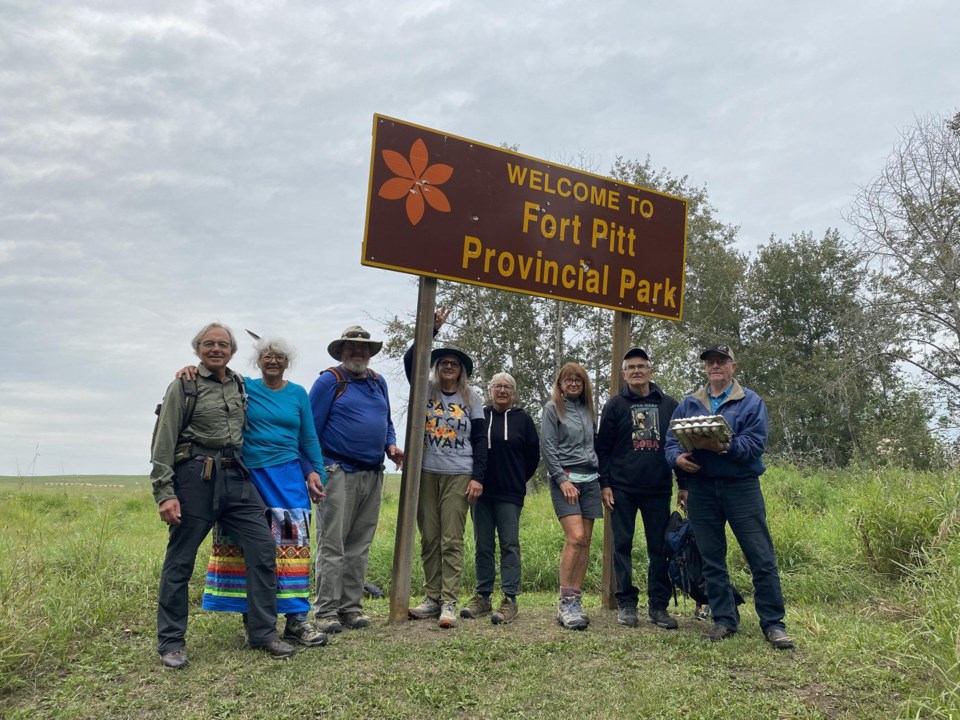SASKATCHEWAN — There is at least one shared output in the challenges that arise while walking for days on end in the vast lands of Saskatchewan: the wandering mind.
The thinking brain poses questions between the monuments and signs and the plains. For Louise Bernice Halfe, it’s an exercise in focusing on the walk itself — and what it offers.
Halfe is one of the regulars in bi-annual trail walks organized by the Saskatchewan History and Folklore Society. The trail walks, now in their fifth official iteration, make a point of featuring Indigenous history and folklore as well as recounting stories of colonial retelling.
“There’s too much anger,” said and a survivor of Alberta’s residential schools.
The walks formally started in 2015 and run every other year across a new region in Saskatchewan. This year’s walk started earlier this month in Fort Battleford and ended at Fort Pitt Provincial Park, northwest of North Battleford. Halfe and half a dozen other walkers ended the 10-day journey with a picture at the welcome sign to the park.
On the final leg of their journey this year, the route brought them past a welcome sign to a farm that read: “Alone we are strong, together we are stronger.”
Several of the participants, including Halfe, took pictures with it. The message is a reminder.
Hugh Henry, president of the Folklore Society and organizer of the trail walks, plans and organizes the walks to be as safe and enjoyable as possible. While the nature of the walks themselves may invite participants into a space of contemplation, they are full of opportunities to see and hear accounts of Saskatchewan history.
“It’s important to think how to combine the history and geography, First Nations and Metis connections past and present,” Henry said.
“It’s a part of an interest and the learning experience all around.”
This year they visited various Battleford-area historic sites, learning about English and Metis history in Delmas and Bresaylor. They also visited Frenchman Butte National Historic Site and the Poundmaker Interpretive Centre.
The format is perhaps what makes the walks so memorable: an invitation to learn the history of the land is complemented by the experience of walking in the silence of its truth.
Matthew Anderson, who devised early editions of the walk with Henry, said he has long sought to understand history through the lens of Indigeneity. He and writing partner Ken Wilson published an academic paper on the subject. Anderson, a longtime academic, is working on a book about journeying across the Prairies.
The questions that arise for Wilson and Anderson in their work and philosophical musings surround colonial thinking on matters such as land ownership, trespassing, the right to roam, and what counts as public land.
“We talk about the notion of walking on the land as a form of embodying land acknowledgement,” Wilson said.
People are busy, with lives and matters to attend, Henry said.
“By being on the land and walking the land, experiencing the land, you are considering ,” Wilson said.
“You’re putting meat on the bones of land acknowledgement.”
Anderson grew up in Swift Current. He contacted Henry in 2015 with an idea about a walk. He would have gotten lost if he tried to do these walks alone, he said.
At first, it was just him and Henry on the trails.
“Anybody who has walked long distances, even short distances, realized that within 15, 20 minutes thoughts begin to bubble up in your head,” Anderson said. He calls it a form of meditation that arises from witnessing the land along the way — the rocks, the rivers, the animals, the old abandoned farms on Prairie land.
It’s tough but can be enriching, Anderson said.
“Because then you realize you’re in a permanent relation with the treaties and Indigenous people — and part of that treaty is the sharing of that richness … They allow us to think about the past and work on decolonizing.”
On the day the walk concluded, Halfe stood with her husband, who is white, her tousled white and silver shoulder-length hair flying in the wind around her tanned face, which canvasses her emphatically big brown eyes. The group snacked on carrots, cherry tomatoes and assorted seeds. They were amongst kin.
There was no grand celebration of their finish. Rather, there was victory in the calm. Perhaps that is the lesson and the gift, the participants mused: peace.
Ten days, upwards of 190 kilometres. Thirty walkers altogether. The fifth trail walk, is complete.
Halfe said she's encouraged by the willingness of participants to venture into a space where they must grapple with the enormity of what occurred in the past and the injustices that persist.
“The bones of my ancestors are underneath us in every walk that we’ve had,” Halfe said. “I think they’ll continue to examine our history, the truth of our history. Instead of blaming the victim.”
You can no longer count on social media to deliver important news to you. Keep your news a touch away by bookmarking SASKTODAY.ca's homepage at this link.
Here's why you should bookmark your favourites.
Subscribe to SASKTODAY.ca newsletter to get our daily news to your inbox.



